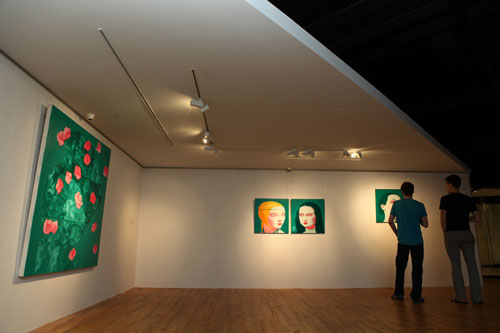MOURNING IN GAUDY COLOR – THE ART OF FENG ZHENGJIE
Feng Zhengjie is regarded as a representative and master of Chinese gaudy art by the critics. Elements of visual beauty in “gaudiness” concept and commercial fashion of today are perfectly integrated in his paintings, and he is very popular in the art and fashion circle worldwide. This is Feng Zhengjie, an artist from Sichuan province. He has given extending meaning to the bright red and green in folk art while creating effect of irony and criticism. His works are accepted as materialized and fashionable visual expressions in the process of urbanization.
Today, we should all admit that Feng Zheng has contributed a lot to the gaudy art started from the 1990s by some young artists. He has given a typical and templated aesthetic value to the language of gaudy art. Meanwhile, we should also admit that this typical illusion in his works is actually real image that exists everywhere, combining the truth with the fakeness.
However, in Feng Zhengjie’s works during the past ten years, there are more and more sorrow and sadness. This is a tendency worth discussing. In his “fallen petals”series, there is a skull in the pond formed by piles of green leaves. The depth and silence of pond water is emphasized by the pink petals on canvas. It is so quiet, as if only the skull is soul touchingly moaning and murmuring deep in the pond. The loneliness of fallen petals reveals a lasting sigh for life and death. Combining life, death and flowers is a basic idea in Feng Zhengjie’s lasted works. He has also painted a large number of beautiful girls with absent minded expressions, arousing people’s interest and infatuation. However, these largely sized beauties are just shooting stars that can not last, because the vitality in spring and summer is doomed to fade in autumn and winter – In the triptych series “women are like flowers”, skulls and flowers represent this life and next life of the beautiful stars in the middle. All that we take for granted will disappear, all that beautiful and good will fade away. This is not only the fate of women and flowers; this is the fate of all living things.
This sympathy towards life actually appears early in Feng Zhengjie’s postgraduate school works – “Anatomize” series and the later“Recount of skin” series are anatomization of sensitive and weak human bodies in the era full of wants. The red spots on limbs are the price paid for the expanding wants. The wounds are cankering while showing off their bright colors. In this batch of works done years before, a unique rose has already appeared on canvas. Though it takes only a small part of the whole picture and it is depicted by pasting, it is the foundation for him to successfully managing the relationship between portraits and flowers in his later works.
Different green colors and red colors like blushes are basic colors of his works later on. Green colors represent shrinkage, coldness, depth, isolation and hiding. Red colors represent expanding, friendliness, surface, closeness and shallow. These are two opposite mental directions; they are also a complement for scenes on canvas representing Ying and Yang of living lives. In “Romantic Trip”, “Time Channel”, “Cool” and “Chinese Portrait” series, there is always a sharp contrast between red lips and green eyes, showing the restless behind passion. We used to think that green is a color related with vitality and life. But in Feng Zhengjie’s art, green, especially deep green and dark green, usually brings a feeling of inevitable and uncertain secretiveness and an unlucky sign. No one would think that those white and green faces can be related with words such as health, happiness or loveliness. It seems that there is a kind of unspeakable sorrow behind these faces. This feeling is especially obvious in his “Chinese Portrait” series. This series is in international fashion style, and the backgrounds are deeper and deeper green colors. These green colors act as foils to the charming stars, but they also reveal the sadness of artist, as he foresees that these stars at their peak are doomed to fall in future.
About Feng Zhengjie
Feng Zhengjie was born on 1968 in Sichuan Province, China he lives and works in Beijing, China. When Zeng Fanzhi was at school (1987-91), he particularly liked the work of the German Expressionist painters. In the third year of his studies, he put Soviet Realism aside and began to explore expressionistic approaches to painting. His works of this period have further echoes of another of his favorite artists, Beckman, but when it came to creating work for his degree show, the Xiehe series, Zeng Fanzhi had already established his own style and the impact of the work had won him a strong reputation in Chinese art circles…
Feng Zhengjie paints striking contemporary women. With their colored hair, richly hued clothes and luscious, expressive lips, the women appear irresistibly dazzling. And yet, the wandering expressions in their eyes render them elusive and enigmatic.
These strange, unknowable eyes have become Feng’s signature style. Feng studied to MA level at the Fine Art education department of the Sichuan Academy of Fine Art between 1988 and 1995. After 1989, Feng rejected both socialist realism and Western academic art, turning instead to the questions raised by China’s emerging contemporary art scene. He developed a more critical outlook with regards to society. In response to the new issues confronting China, Feng Zhengjie decided to take inspiration from the popular images he had grown up with in rural Sichuan. Critics are unanimous in placing Feng’s paintings in the realm of the critique of contemporary consumer society; this was especially clear in the “Romantic Trip” series, which pictured young couples in the expensive wedding ceremonies now fashionable amongst certain sections of Chinese society.


